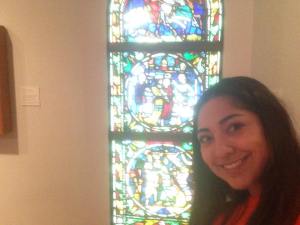

The Krannert Art Museum has a variety of art work and is filled with plenty of art exhibitions to choose from. I have never been to any type of Art museum. Maybe when I was a kid and we went on a field trip, but I never remembered seeing portraits, paintings, and photography—only sculptures. That was back in grade school though, or maybe even early middle school and I did not know what the artists’ work meant or that it even had a story behind it. I still till this day do not really understand most art work, but I do know that their work is always beautiful with a story behind it. Anyways, when I went into Krannert Art Museum for the first time, I was pretty lost. Right to the left there was an “Encounters: The Arts of Africa” but I decided to go straight, then left, then back to the center, and then I was going into different rooms that consisted of different art work collections. These included art collections of: Asia, Americas, Ancient, Decorative Arts, Europe (which was my favorite), Intermedia, Photography, Works on Paper, and lastly, Africa. However, the collection room that caught my eye the most was Europe. In here, the work was from artists: Ugolino di Nerio (Ugolino da Siena), Master of the Saint Ursula Legend, Bartolomé Esteban Murillo (Spain), François Boucher (France), etc…to name a few. This room had all white walls, with portraits all over the walls and maybe two sculptures, the room was very dim because the lights were pretty low-lit, and the room seemed pretty small compared to most other rooms. However, with the room being small, the art work did not seem to be crowded. Every piece of art that was hanging up had the perfect amount of space. What caught my eye in this room was the beautiful Stained Glass Window. It all made sense now why the room was very low-lit. This Stained Glass Window was in the middle of the room and had light shining right through it, which to me was very beautiful.
Most of the art works done in this room were paintings. However, the collection that caught my eye was a Stained Glass Window: Parable of the Prodigal Son, ca. 1215-25 from France. It was a gift of Ellnora D. and Herman C. Krannert. This glass window spoke to me as soon as I walked in through the room. It was a pretty decent size glass, probably almost equivalent to 4 feet. There were multiple glass colors and when the light shined through it, it was just so pretty. I think the value of this glass is very important and was a reason to why the glass was reinstalled and conserved. I also think cutting out each glass piece was very important to this artist, because cutting out each piece straight to the line had to be precise. Overall, I really loved this piece because it made me remember my childhood when I would go to church with my family and it just brought back happy memories.
The picture I chose for my second blog post was of a girl running. There was a sky and clouds in the background, and with sunlight shining through the picture. I think these two pieces of art work are very similar in the sense of the light shining through them and the sky being a part of both art pieces. I relate to both of them because running makes me happy and it is a way to relax my mind. On the other hand, the stained glass window did the same. It made me happy because it brought back early child hood memories of being with my family. These collections of art work are different, because one I consider to be photography and the other is kind of sculpture-like since the artist had to cut out glass pieces and put the glass all together.
I think this piece of art work relates to the church, with Jesus, Mary, and others. At least that is what I first thought of because these are the type of glass windows I see when I go to Catholic Church. However, it does not tell a tale about Jesus, it tells a biblical parable about the prodigal son Luke. This story tells how he loses his wealth through: gambling, prostitutes, drinking, and overall, through “riotous living.” The last parts of the glass scenes show him returning “poor and dejected” to his fathers and brother. Overall, the main plot of this glass parable is “redemption and forgiveness.” Lastly, it is said to believe that this “window probably once decorated the lower portion of a French Gothic church.”
<<http://kam.illinois.edu/collection/europe/StainedGlass.html>>
